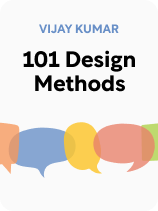

This article is an excerpt from the Shortform book guide to "101 Design Methods" by Vijay Kumar. Shortform has the world's best summaries and analyses of books you should be reading.
Like this article? Sign up for a free trial here.
What is 101 Design Methods by Vijay Kumar about? What are the main takeaways of the book?
In 101 Design Methods, Kumar lays out a systematic approach to innovation management involving the completion of seven innovation tasks. Kumar also discusses a number of specific tools and techniques you can use in the course of completing an innovation project.
Read below for a brief overview of 101 Design Methods’ main ideas.
101 Design Methods by Vijay Kumar
Professor Vijay Kumar observes that many businesses claim to value innovation, but few succeed in consistently bringing innovations to market. The reason for this, he says, is that many companies don’t understand how to manage innovation—some don’t even realize that innovation can be planned and managed like other types of projects. To solve this problem, he lays out a systematic approach to innovation management in his book, 101 Design Methods.
(Shortform note: In the title, Kumar appears to be using the term “methods” similarly to how it’s used in computer science, rather than in common speech. In object-oriented programming, a “method” is any action or function that can be executed. Kumar’s “methods” include a wide variety of specific tools (such as cluster maps and comparison tables) and actions (such as calling a meeting with your stakeholders) that you might use in the course of managing an innovative design project.)
How to Manage Innovation Projects
Kumar explains that there are a few general principles you need to follow for your company to consistently produce successful innovations.
First, you need to understand that you can plan and manage innovation projects. If you don’t believe that, you’ll probably end up either shying away from innovation projects or letting them run without enough structure to make them successful.
Second, Kumar says the structure and culture of your company need to promote a free flow of ideas throughout your organization. Different departments like marketing, finance, and engineering need access to each other’s expertise, and workers on the floor need to communicate with executive decision-makers.
This is because innovation is inherently multidisciplinary: Products and services are never used in total isolation, so you need to consider the whole system of interconnected products, services, and relationships that affects your users’ and other stakeholders’ experiences with your product.
Further, everyone brings a slightly different perspective to the table, so you need everyone’s insight to find the opportunities for innovation that others have overlooked. Kumar also says that successful innovation requires extensive interaction between the executives who determine corporate strategy and line-level workers like salespeople and engineers.
The Seven Tasks That Make Up Innovation
Beyond the general principles we just discussed, Kumar’s approach to managing innovation consists of breaking down the innovation process into seven tasks that you can plan, schedule, and manage.
The seven tasks that Kumar identifies follow a logical progression, but sometimes you have to revisit earlier tasks later in the project or cycle through multiple iterations of the whole sequence. He shows how you can keep track of where your project has been and where it’s going using a graphic map that shows the seven tasks and charts your path through them. The map also shows a pair of axes indicating how the focus of the different tasks varies from theoretical to practical and from learning about what already exists to creating new things. Here are the seven tasks in order:
- Develop a clear idea of what you intend to accomplish
- Define your operating environment
- Understand your stakeholders
- Develop a mental model
- Brainstorm solution elements
- Assemble and evaluate comprehensive solutions
- Plan to implement the solution
Tools to Use on Innovation Projects
In the remainder of this article, we’ll present some of the more broadly applicable tools and techniques, how they’re useful, and when you would use them.
We’ll start with some graphical tools in this section and then cover techniques that Kumar recommends using in the next section. Note that Kumar sometimes presents slightly different variations or applications of the same tool as separate “methods,” but we’ve combined them in our discussion.
Two-Factor Cluster Maps
Arguably Kumar’s favorite tool (based on how many variations of it he presents and the scope of what he applies it to) is what we’ll call the two-factor cluster map. To create this map, label the two axes of a scatter plot with properties you want to compare. Then, mark on the plot where different products or services you’re researching fall. This may reveal important relationships or opportunities if you find that the dots cluster together in some areas while other regions of the plot are empty.
Comparison Table
Another tool Kumar uses extensively to compare properties of different products, services, or options is the comparison table. To build a comparison table, label the rows and columns of a table with the things you want to compare. Then, in the box where they intersect, describe how that row and column relate to each other. This ensures that you compare every possible combination.
If you want to compare several different products, you might list the products as rows and factors of interest as columns, as shown below. You can color-code boxes with similar results to make the similarities stand out.
After doing your initial comparison, you might rearrange the rows as shown below to make similarities and other patterns stand out more clearly.
Techniques to Use on Innovation Projects
As we’ve discussed, Kumar’s “methods” include both tools and techniques. We’ve covered some of his key tools. Now we’ll examine some of his key techniques.
Monitor Key Media Sources
Kumar advises you to stay informed about new developments—not only in science and technology, but also in culture, politics, and other current events—by monitoring media sources and synthesizing relevant information from them. As you summarize key information from the media, periodically discuss this with your team, and keep your media synopsis files in a database or shared folder where everyone can access them.
This is most useful during Tasks 1 and 2, where you’re identifying trends, choosing a direction for your innovation project, and researching your operating environment, but the repository of information that you create will become a valuable reference throughout the project.
Kumar notes that different media sources are good for collecting different kinds of information. Popular mass media tends to focus on current social and political events. Social media shows you what people are talking about and how they feel about issues or products. Scientific journals and other professional publications describe the latest technical developments in a field.
Watch Users in Action
As Kumar explains, you often gain special insights from watching someone do something. These are discoveries that you would never make by just thinking through the process or talking to users about it. So setting up real or simulated scenarios for users to interact with the product is a powerful tool for deepening your understanding of users’ experiences. This tool comes in handy during several of the tasks of innovation.
During Task 3, when you’re learning about your users, Kumar recommends watching them work with existing products—preferably in the setting where they normally use them, although staging specific scenarios for them to work through at your facility can also be useful if you need to focus on a specific issue.
In Task 5, observing how users interact with a prototype or simulation of one of your solution elements may give you ideas for additional improvements or other solutions. In Task 6, it can help you evaluate solutions, and in Task 7 it lets you validate that your solution will work the way you envisioned it working.
Hold Workshops
In addition to product usage simulations, Kumar discusses a number of workshop activities that can be helpful at various stages of the innovation process.
In Task 3, where you’re working to understand how your prospective users think and feel about things, Kumar recommends compiling a folder of photographs showing a variety of people and items in different situations. Then, set up a workshop where you ask users to organize the photos thematically or arrange them into a sequence that tells a story. When they’ve finished, have them explain their choices to you. This may reveal feelings or associations they harbor that you would’ve overlooked otherwise.
For example, maybe you ask them to pick out photos they would associate with good customer service versus bad customer service. You might notice that the “good” photos they pick out are all brightly colored, while the “bad” photos tend to show drab, sterile, office settings. This reveals something about how the setting in which their service needs are addressed impacts how they feel about the service.
Similarly, in Task 3, Kumar suggests designing workshop exercises to incorporate cultural artifacts—things that have social significance in a particular culture. For example, maybe a certain card game is widely popular within a certain culture. So, at a workshop designed to engage users from that culture, you pass out decks of cards and ask them to select a card that expresses how they feel about the purchasing process, the user interface, and other aspects of the product or how they interact with it. Their responses will give you insight into their culture and how it colors the user experience.
In Task 5, Kumar says sometimes you can make your brainstorming sessions more effective by turning them into a game. For example, you might create several decks of cards: one that lists a user profile on each card, one that lists a certain aspect of the product on each card, one that specifies a certain use case for the product, and one that specifies a certain stage of the product life cycle. Players are dealt a random assortment of cards from all four decks and get points for coming up with unique solutions for the situations represented by their cards.

———End of Preview———
Like what you just read? Read the rest of the world's best book summary and analysis of Vijay Kumar's "101 Design Methods" at Shortform.
Here's what you'll find in our full 101 Design Methods summary:
- Why many companies don’t understand how to manage innovation
- A systematic approach to innovation management
- Specific tools and techniques you can use on innovation projects






